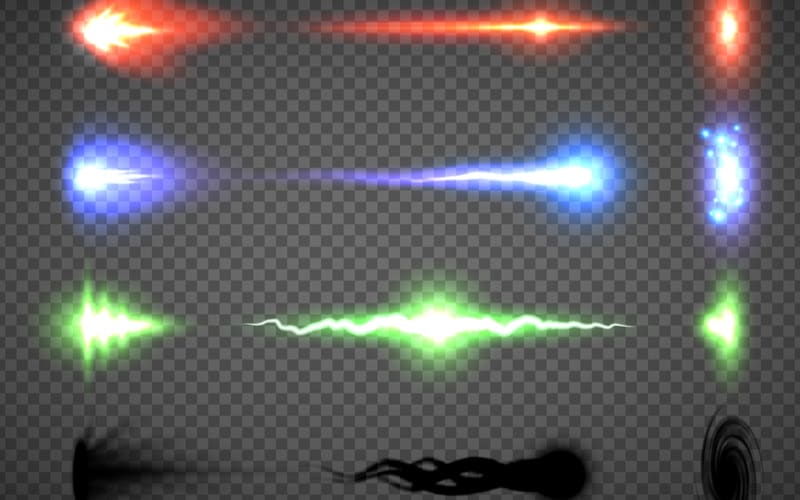Blasters are some of the most common weapons used throughout Star Wars. These weapons come in many forms such as cannons, rifles, and pistols, and they work by igniting gasses in the magazine, creating powerful beams of energy that can damage and kill targets.
The fire produced by these guns, known as blaster bolts, comes in a variety of different colors. But why? What is the purpose and meaning of each color?
For some, the answers are clearly provided in Star Wars canon; for others, we can only speculate.
Read on to learn more about each of the seven blaster bolt colors seen in Star Wars.
1. Red
Red is the most common blaster bolt color. It is seen in many instances throughout the Star Wars movies and other media.
Red blaster bolts are produced by a relatively cheap gas, which is part of the reason for their popularity. This gas is readily available and widely used in the majority of blasters.
The gas that produces red blaster bolts isn’t as powerful as some other types, but it is still powerful enough to kill living targets and melt through armor.
Red blaster bolts were produced by the weapons of the Confederacy of Independent Systems during the Clone Wars.
Later, during the Galactic Civil War, the gas producing these colors was used almost exclusively by both the Empire and the Rebel Alliance.
It remained the most popular choice during the First Order-Resistance War, as it was used primarily by the First Order.
Since it is cheap and readily available, it is also commonly used by bounty hunters, law enforcement, civilians, and others throughout the galaxy.
2. Blue
Blue is a less common blaster bolt color than red, but it is still used fairly often.
Blue blaster bolts are produced by a special ionized gas which makes them highly effective against machinery, such as droids.
For this reason, the Republic used it during the Clone Wars to combat the Separatists’ battle droid armies.
Though used primarily for taking out droids and other machines, blue blaster bolts were also highly effective against living beings. This is shown clearly during the events of Order 66, when we see clones killing Jedi with their blue blaster bolts.
Though the ionized gas responsible for blue blaster bolts was mostly used during the Clone Wars, it was also a common choice of the Resistance fighters decades later.
3. Green
Green blaster bolts are much more rare than both red and blue.
Bolts of this color are produced by a more expensive and high quality gas, making them less popular but much more powerful.
Green bolts are highly effective against both organic and inorganic materials, meaning they can kill or destroy a wide variety of targets.
Even if they don’t kill a living being, well-placed shots can easily break bones and cause extensive internal damage.
The gas used to produce these bolts has been most notably used by the Naboo Security Forces.
It was also used in the ships of the Empire’s Starfighter Corps, as well as the Umbaran people during the Clone Wars.
Green is also the color of bolt most commonly fired from bowcasters, which are the weapon of choice for Wookiees. A notable exception is Chewbacca, who fired red bolts from his bowcaster.
4. Yellow
Yellow is a much less common blaster bolt color, and its meaning or purpose within Star Wars is unclear.
Yellow blaster bolts are used almost exclusively by the Mandalorians, but there is no explanation within Star Wars canon for why the bolts are this color.
It’s possible that the gas used within their blasters is a different type or quality, or perhaps their blasters are designed to have a unique effect on the gas. Although, none of this has been confirmed.
The yellow bolts fired by Mandalorian weapons do not appear to be more or less powerful than those of any other color. With this in mind, it has been suggested that yellow is simply a variant of another, more common color.
5. Purple
Purple blaster bolts are pretty rare, but they have made sporadic appearances throughout the Star Wars franchise.
As with the yellow color, it’s unclear what qualities or purposes set purple blaster bolts apart. They appear to be no different than any other bolt color.
It is possible, given their color, that they are a cross between red and blue bolts, but this has not been confirmed.
It is speculated that this color originated on the planet Geonosis, as it was the color used in Geonosian starfighters. The Subjugator-class cruiser known as the Malevolence also fired purple blaster bolts.
The most notable users of this blaster bolt color were droids belonging to the Magna Guard. The tri-droids of Skako Minor also fired purple bolts during the Clone Wars.
6. Orange
Orange blaster bolts are produced by a less powerful gas; this results in low-impact, non-lethal bolts.
As you might imagine, these bolts serve little purpose in a battle; that said, they are excellent for training.
They were most often used to train young clone cadets on the planet Kamino during the Clone Wars. They were fired by training droids and remotes during various exercises to simulate situations that soldiers would face on the battlefield.
Another notable use of orange training bolts can be seen in the original Star Wars movie, A New Hope. While traveling on the Millennium Falcon, Obi-Wan Kenobi instructs Luke Skywalker as he attempts to block orange blaster bolts from a training orb.
7. Cyan
Cyan blaster bolts are light blue in color, denoting their similarity to regular blue bolts. That said, they are much less powerful than blue bolts.
With this in mind, cyan bolts are also commonly used for training purposes. They are still ionized, but they cannot kill or seriously injure a living being.
The gas responsible for producing cyan bolts was used in the clone cadets’ training blasters before and during the Clone Wars. This simulated real-life situations they would experience on the battlefield.

Sarah Hood is a freelance content writer and editor with a love for all things Star Wars. When she’s not writing, she enjoys cooking, singing, and spending time in the great outdoors.
